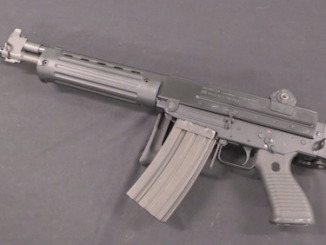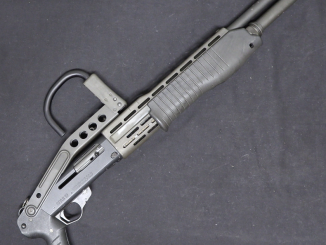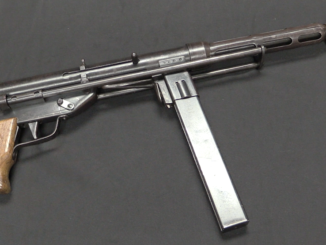The Breda PG (“Presa Gas” – Gas Operated) was developed by Sestilio Fiorini in 1931 and put into production at Breda’s factory in Rome. It was offered as a weapon for commercial sale and export, as well as being one of the several entrants in Italy’s semiautomatic rifle trials in the late 1930s. Unlike most of the other competitors in that trial, the Breda PG did actually find a commercial buyer (albeit a small one).
The government of Costa Rica purchased 800 PG rifles. These were designated Moschetto Automatico, as they were equipped with a 4-round burst option as well as semiautomatic They fired from an open bolt (in both semiauto and burst modes) and were chambered for the 7x57mm Mauser cartridge, which was a common and popular round in Latin America at the time.
The Italian military trials rifle was somewhat different. In addition to using the standard Italian 6.5x52mm Carcano cartridge, it was semiautomatic only and fired from a closed bolt. These were designated Fucil Semiautomatico, and only a few hundred were made (at most).
Both versions used large detachable box magazines, including 20-, 30- and even 50-round varieties. The Costa Rican version of the gun shows some elements of the coming assault rifle style of firearm, but it’s rifle caliber cartridge and open bolt operation (and its awkward handling) prevented it from showcasing the possibilities of that style of firearm.




Nice Video!!!!
Looking at this I can’t help thinking Breda accidentally turned a good light machine gun (automatic rifle)action design into a mediocre semi-auto. Remove the burst mechanism and change up the furniture and remove the mag window and it looks rugged enough to be effective. Gas piston may not be conducive to a quick change barrel but it does look chunky enough that a solution could be designed.
For the Italian trials version, yeah. It could have been a great LMG, especially using the Breda 31 (that will become the Breda 37, 38, 20/65, 37/54…) style gas piston for a quick exchange barrel.
But in semiauto only, is like someone submitted a semiauto version of the BAR to the US semiauto rifle trials.
For the Costa-Rican version, the burst was a request of the customer, or at least a possibility that they preferred over the full auto.
It’s really not all that different in concept from the much later American M16A2 in the U.S. Army version, which has safe, semi-automatic, and 3-shot burst settings, with no full-automatic setting at all. The idea being that since muzzle limb means most of a full-auto burst at cyclic will go skyward, limiting burst fire to three or four rounds will get the job done without wasting ammunition or endangering low-flying ducks. The H&K G-11 caseless weapon had a three-round burst setting more or less for that reason, as well as increasing target suppression probability with its small-caliber round.
One peculiarity of the M16A2 is that since its burst-fire setting is controlled by a rotating cam, if you set it for Burst, and squeeze the trigger but release it before all three rounds are “gone”, firing only two rounds, that means the cam has only rotated 2/3rds of a complete revolution.
So, the next time you squeeze the trigger, instead of another three-round burst, you get a single round and have to release and squeeze the trigger again for a burst.
There are different ways to set up an autofire searage for burst fire as opposed to full-auto. The M16A2 method is one of the less satisfactory.
cheers
eon
So what is that recoil spring trapdoor for? Quick replacement perhaps?
Field strip. To disassemble the rifle requires time, but you have access to all the parts that more frequently requires cleaning/replacing (gas chamber, recoil spring, bolt and firing pin) in seconds.
Ahh…that’s right! Otherwise to gain access to that recoil spring assembly requires near complete tear down! Thanks!
Cut-outs in magazine seems to invite dirt. Am I wondering why are so big? For check of number of cartridge much smaller would be enough, even if you want allow tactile check, so it seems to be “skeleton magazine”, possibly to cut mass of complete weapon. Does “Italian” samples also feature cut-outs?
Rather like the Chauchat in WW1, the idea seems to have been that dirt and etc. is going to get into the magazine no matter what. So the large “windows” allow the gunner to shake it out, or maybe get physical by giving it a few brisk raps against his boot or a handy tree limb to persuade the crud to leave. Or even dunk it in a stream and swish it around a few times, take it out, shake it off, and continue the mission.
Not exactly the way you’d like to treat part of a precision instrument, but Mother Nature has never been particularly impressed by the sanctity of human technology. Sometimes you have to “get medieval” to undo her mischief.
cheers
eon
Today, not having first hand experiences, we tend to be schematic. Cut out in magazines = “Dirt will lock the action every three rounds!”; a screw = “imagine to have to do that on the field under fire!” (imagine to have to completely take apart a M1 Garand on the field under fire to replace the firing pin , but IRL it did pretty well anyway).
But windowed magazines are not more dirt than belts and trays. A screw is almost always the designer telling to you “you don’t have to disassemble this part every time, there is not that much that’s happening under here” ecc… ecc…
“(…)Dirt will lock the action every three rounds!(…)”
I don’t said so, only it would be more dirt sensitive.
If you don’t consider “skeleton” magazine a handicap, name few other self-loading rifles using such solution.
I didn’t say you said that.
Cutout mags for AK47 had been routinely made, and used. They are not the best solution, but they are not so abysmal. What keeps on being used and what’s ultimately discarded is often a question of nuisances.
When I had this gun first time in my hands, I was impressed with its apparently fine machined breech mechanism. What I did not like was shape and disproportion of butt relative to front portion. This is certainly meticulously designed rifle, although its cost vs. utility may be in question.
To relate to complexity of gas piston arrangement, I’d suggest to look at an alternative – vz.52 or 52/57; lot simpler and slimmer package overall. I understand advantage of circumferential gas cylinder as means to avoid offset force, however one has to ask if it is worth of the effort.
Such solution was also tested in Soviet Union, namely in АО-22 machine gun, see photo:
http://raigap.livejournal.com/571899.html
Universal machine gun by Грязев, Любимов and Касторнов
Caliber: 7,62x54R
It’s designation (АО-…) reveal that it was made in ЦНИИточмаш (Klimovsk), considering from its number it was possibly created in late 1950s/early 1960s
further data unknown
Soon designers abandon such layout and go for classic one, which give АО-22М machine gun:
http://raigap.livejournal.com/572089.html
Universal machine gun by Грязев and Любимов
Caliber: 7,62x54R
Locking against barrel, feed mechanism analog to KPV, ejection direction: forward-bottom
Mass: 6,18 kg
Rate-Of-Fire: 700-800 rpm
Quantity of elements: 98
Term “koltsevoy dvigatel avtomatiky”…. does it refer to circumferential piston? In barrel area it actually looks slim.
Yes, literally “ring engine of automatics”
“looks slim”
My understanding is that gas mechanism actually starts near bipod (cf. АО-22М)
Peculiar version of that gas-operation was used in МР-153 shotgun:
https://ru.wikipedia.org/wiki/МР-153
(known also under name Baikal MP-153 and Remington Spartan 453)
although around magazine rather than barrel
These self-loading shotguns appear to be of common design:
http://baikalinc.ru/ru/company/95.html
Typically, for this type of arm, gas valve is co-axial with magazine tube.
Possibly some misunderstanding here. Images should help.
You can see field strip procedure in photos here:
http://slobfishunt.ru/oruzhie/sborka-razborka-oruzhiya/razborka-mr-153.html
examine photo number 7, taking look at поршень
Now I see that I overlook that Modern Firearms has MP-153 description:
http://modernfirearms.net/shotgun/rus/mp-153-e.html
it described this solution as using (…)gas-operated action with annular piston, located around the magazine tube(…)
Description here also explain possibly source of choice of such arrangement
It was developed simultaneously with the pump-action MP-133 shotgun and shares many parts and assemblies with it.
Thus such solution possibly allows higher parts commonality than “normal” gas operation.
Such solution is also used in Bekas-Auto shotgun:
http://modernfirearms.net/shotgun/rus/bekas-auto-e.html
which also has pump-action sibling
Btw, those ‘gas pistons’ on self-loading shotguns are pretty sophisticated since they contain self-regulating pressure valves. This is apparently necessary due to varying loads and types of shots they are suppose to handle. Look at Beretta or Winchester, they are similar in that regard. They can shoot little faster than slide action, but that depends of shooter’s skill. Not worth of the money; but they are fancy to be sure.
“Not worth of the money”
So why several self-loading shotguns were created?
I actually suspect that they didn’t want the gas piston arrangement to be lighter. Mind that this rifle had to fire full power cartridges. To have the rifle point heavy helps to control the bursts AND an heavy reciprocating arrangement helps to lower the fire rate. The gun is given for 600 RPM, that, with an open bolt design, and a light and short recoiling bolt, is half a miracle.
Technically, the 7 x 57mm and 6.5 x 52mm are both “intermediate power” rounds, and were even then. Note that practically every 7mm caliber intermediate round developed experimentally from WW1 to the 1950s (.276 Pedersen, 0.280in Enfield, etc.) were ballistic “twins” of the 7 x 57, and even had cartridge case dimensions and etc. remarkably close to it as well.
They could probably have all saved themselves a lot of trouble by just chambering their “intermediate” rifles for 7 x 57mm from the start. Thereby getting the performance they wanted without having the stumbling block of converting manufacturing plant to a completely new cartridge;
Remington; “You want us to manufacture several million rounds of a brand-new .276 cartridge? That will take a couple of years and several million dollars to set up.”
Designer; “Ouch. Army Ordnance will never go for that. What about 7 x 57mm Mauser?”
Remington; “7 x 57? Full-metal-jacket? Sure, we have ’em in the warehouse right now, how much do you want?”
Hey, it could have happened that way.
😉
cheers
eon
“Technically, the 7 x 57mm and 6.5 x 52mm are both “intermediate power” rounds, and were even then.”
I am not sure about that, if 7 x 57 was intermediate, then which country used it alongside full-power rifle cartridge?
–
Anyway Denmark seems to be on way to adopt 7 x 44 cartridge (8 g Spitzer @ ~750 m/s):
https://www.arma-dania.dk/public/timeline/_ad_patroner_view.php?editid1=38
but outbreak of Second World War halted that
“(…)
Remington; “7 x 57? Full-metal-jacket? Sure, we have ’em in the warehouse right now, how much do you want?”
Hey, it could have happened that way.
(…)”
Didn’t equipping U.S. forces with shotguns during First World War looks similar? That is: add bayonet and heat shield and we bring.
is: “(…)bayonet and(…)”
should be: “(…)bayonet lug and(…)”
So what if the stock was redesigned for better handling and the magazine made without any slots cut into the sides?
I’d be for it – it is ‘butt’ ugly. Also, substantial simplification of gas piston is in order. I so not see that much of issue in open-bolt concept as long as its mass is not large (which appears to the case).
Cuts in magazine is something which does not add up to me. As far as I recall, the specimen I saw did not have it; but it is long time, I am not sure.
Looks like an inordinately expensive gun to produce, for example that little buffer block alone seems to require multiple machining operations, and the bolt hold open on empty magazine system requires 3 or more parts.
I’d love to get a Winchester Model 55… A single-shot .22 that fires from an open bolt!
Costa Rica’s last civil war in 1948 resulted in the winner disbanding the army in favor of a national police agency. There were also lots of Italian made SMGs in use. I suspect not many of these survived the post-civil war era. Wasn’t there yet another Italian open-bolt self-loader used by Costa Rica? I seem to recall one in another of Ian’s Forgotten Weapons episodes from some time ago… Perhaps about the time he demonstrated that the Cei-Rigotti was 7.65x53mm Argentine caliber, not 6.5mm Carcano?
https://www.forgottenweapons.com/early-semiauto-rifles/cei-rigotti/
The size of the stock was probably set up for the Joe average trooper. We need to remember the Costa Rican trooper of 1935 was a whole lot smaller then gun reviewer of america in 2017. Our whole tall people are rich idea comes from until a generation ago you had to be a farmer or rich to give your kids milk every day.
I don’t see a problem with the random first burst in burst mode. A misfire would leave the bolt closed and an empty magazine would prevent the bolt from closing. So your trooper (who isn’t counting his shots anyway) will engage one more target at the end of the magazine when the hold open tells him to reload.
RG
And the trooper will have no chances of getting full auto “walk up,” where the weapon becomes uncontrollable due to recoil impulse moments of inertia relative to the shoulder or wrist. There is a good reason soldiers are not allowed to play Rambo style in training. Or am I wrong?